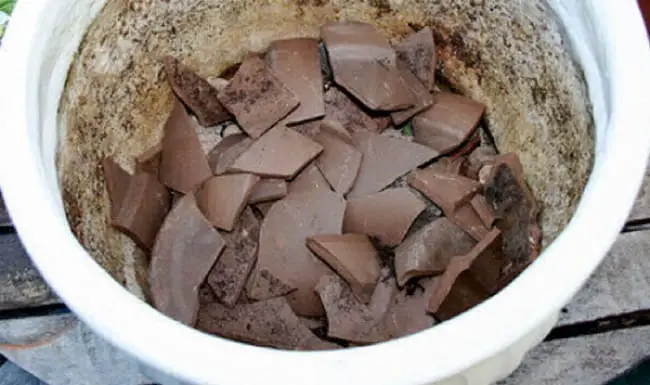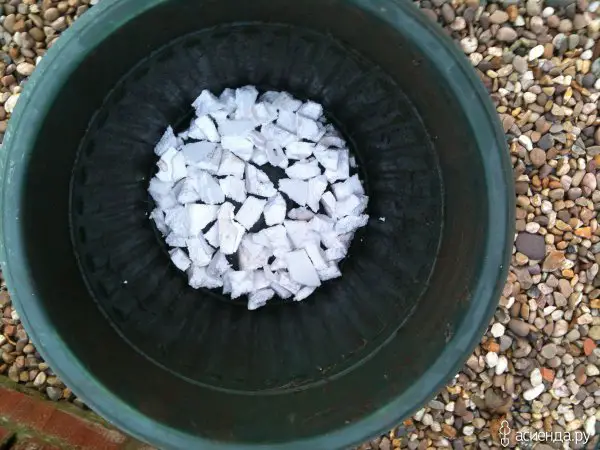Compliance with agrotechnical rules is necessary for the normal development of both crops and indoor plants. Also, certain requirements are imposed on the composition of the soil, which is so important for the root system of home flowers.
Want to know about drainage for houseplants? What material is used and the correct laying of the drainage layer. All that will be considered in this article.

What is the drainage for houseplants?
The drainage for houseplants: For the normal functioning of the root system, indoor plants require soil containing about 50% of the volume of solid particles, 35% of moisture, and 15% of voids filled with air. These conditions can be provided only by creating a drainage layer of coarse material.
The absence of air in the soil is favorable conditions for the reproduction of fungi and bacteria, which cause rotting of the roots and the subsequent oppression of the plant.
Another function of drainage is to ensure that excess water drains out quickly when watering. This condition is especially important for plants that cannot tolerate excess moisture.
Take a look at DIY Self-Watering System For Indoor Plants
what to put in bottom of planter for drainage?
Any coarse-grained material that is chemically neutral, resistant to decay and destruction, and does not compact over time is suitable for soil drainage.

The following materials have these characteristics can be used for drainage for houseplants:
- natural origin pebbles and gravel;
- specially prepared sterilized expanded clay of the same fraction, vermiculite or perlite;
- improvised materials – pieces of bricks, fragments of ceramics, and foam.
All of the above material differs in thermal conductivity, which affects the temperature of the root system of plants, the ability to absorb water, and also has other advantages and disadvantages depending on the physical and chemical properties.
Expanded clay drainage for houseplants
Expanded clay is a thermally treated clay with a porous structure. Its main purpose is insulation and sound insulation of building walls during construction.
Expanded clay used for drainage is preliminarily subjected to fractional selection, washed and disinfected. Calibration is also carried out for small, medium and large fractions.
Due to its porosity, expanded clay absorbs excess moisture well, and also has high thermal insulation rates, maintaining an optimal temperature for the roots. This material degrades within about 6 years, so it needs to be replaced.Attention! The chemical neutrality of expanded clay is disputed by some florists, who claim that it increases soil acidity. However, this material is the most common choice for creating a drainage layer.
See also Best Mulch For Indoor Plants
Ceramic shards used as drainage for houseplants
Broken ceramic shards can be used to drain the soil. It also has a porous structure, which allows it to accumulate moisture and gradually release it into the ground, preventing the soil from drying out completely. The density of ceramics is higher than that of expanded clay, which leads to longer service life in comparison with the latter.
The sharp edges of the ceramics must be dulled in order to exclude mechanical damage to the plant horses. Ceramic shards are placed on the bottom of the planting container with the concave side down. Additionally, it is better to sprinkle the top layer of ceramics with expanded clay.

Perlite and vermiculite
Perlite and vermiculite have higher drainage properties. Therefore, these materials are the most expensive.
Perlite is a processed volcanic rock. It is a gray or white porous granule.
Vermiculite is a fired layered mineral from the hydromica group. During heating, the layers are divided into flakes that form pores.
Both perlite and vermiculite are capable of absorbing water and then returning moisture when the soil dries out, and also have excellent thermal insulation properties.
Check it out how to sterilize garden soil for indoor plants?
Sphagnum moss drainage for houseplants
Some florists use sphagnum moss as a drainage layer. It, like a sponge, absorbs a large amount of moisture, preventing the soil in the flower pot from drying out.
Sphagnum is quite rare on sale, but you can prepare it yourself. It is advisable to do this in the autumn period, since at this time it is easier to keep the moss in proper condition during transportation. Before use, it is soaked in warm water to saturate it with moisture and remove insects.

Sphagnum moss is stored in a cool place in a package that provides air access to it. Freezing of this raw material is also possible, since the properties of moss are not lost during defrosting.
what can i use for drainage in potted plants? Other Options
If it is not possible to purchase industrial drainage, you can use scrap materials instead. Suitable for this:
- crushed stone;
- broken brick;
- Styrofoam;
- river stones.
In some respects, the above materials are inferior to industrial ones; nevertheless, they are successfully used by florists.Attention! It is necessary to use improvised raw materials as drainage with caution, because in this way it is possible to introduce pathogens of fungal and bacterial diseases into the soil.
Charcoal as drainage for houseplants
In addition to the function of removing and absorbing excess moisture, charcoal enriches the soil with minerals and disinfects it, preventing rotting, and absorbs salts. It is light and does not affect the weight of the flower pots.
Charcoal is placed on the bottom of the planting tank with a layer of about 2 cm, while only the coarse fraction is used.
May also like growing two plants together in one pot.
Crushed stone, gravel, river stone
These materials are generally available, but you need to calibrate them yourself, sift out the debris and pre-rinse them in water. Their disadvantage is their high specific gravity and high thermal conductivity. Therefore, they cause hypothermia of the roots of indoor plants at low temperatures or overheating when placing pots on windowsills above radiators. To improve thermal insulation, a layer of expanded clay, perlite or other porous material must be laid on top of crushed stone or gravel.
Broken brick used as drainage for potted plants
The properties of broken bricks are similar to those of ceramic shards. Before using it as drainage, the sharp edges are dulled to prevent root damage. After this procedure, it is washed from dust and debris.
Broken bricks are used for plants that store moisture in the leaves and stems and are able to do without holes in the bottom of the planting container.
Styrofoam as drainage for indoor plants
Polyfoam is a lightweight porous material. Besides, it is generally available. It removes excess moisture without absorbing water, therefore it is inferior in quality to perlite and expanded clay. Nevertheless, due to its thermal insulation properties, the foam maintains the necessary temperature for plant roots.

Attention! It is better to create a drainage layer of foam for those indoor plants that require frequent replanting or have an underdeveloped root system. Over time, the roots of the plant grow into the foam, after which it is impossible to release them without mechanical damage.
Why do we need drainage holes in a flower pot?
In addition to raw materials for the drainage layer, it is important for each type of indoor flowers to choose the appropriate planting container with holes in the bottom of the required size. For moisture-loving plants, their diameter should be minimal – 0.5 cm, for succulents – at least 1 cm. If the diameter of the holes does not match, the outflow of moisture from the soil will be disturbed, which will lead to either waterlogging or drying out of the soil.
How to make a drainage layer correctly?
It is better to either completely renew the drainage when replanting plants, or thoroughly flush out soil particles when reusing. The thickness of the drainage layer depends on the type of houseplant, the height of the pot, the number and diameter of holes in the bottom of the container.
How to determine how thick the layer should be:
- with a small number of holes in the bottom of the flower pot, a high layer of drainage material is required – up to 1/4 of the height of the pot;
- if the number of drainage holes is greater, it is necessary to make a middle layer of drainage material – 1/5 of the height of the flower pot;
- for pots with a large number of large diameter holes, a low drainage layer is suitable – 1/6 of the height of the planting container.
Drainage with high thermal conductivity (crushed stone, pebbles, river stones) must be covered with a layer of porous materials – expanded clay, vermiculite or perlite. The size of the drainage material should be smaller than the holes in the bottom of the flowerpot and cover the bottom with an even layer.
You want to know about Why Do Indoor Plant Leaves Turning Yellow And Brown?
How do you improve drainage in potted plants?
Florists make the following mistakes when making drainage:
- Use of sand that is compacted and does not allow moisture to pass through.
- Fraction of drainage material over 3 cm, which does not retain moisture.
- The use of organic materials that rot over time.
- Use of chemically unstable materials.
- Laying drains with sharp edges that damage the roots of indoor plants.
Plant health, growth, and development depend on the condition of the soil and the drainage layer. Correctly laid drainage for houseplants will provide the required humidity for a particular type of indoor plant.
